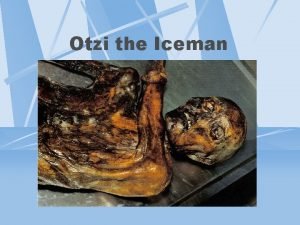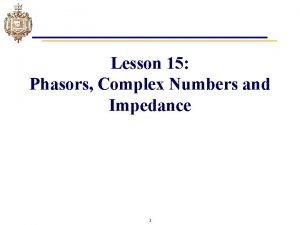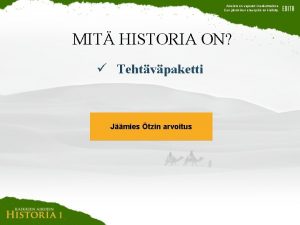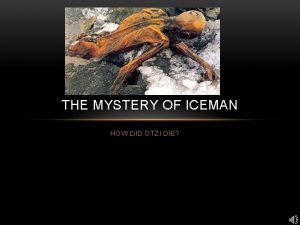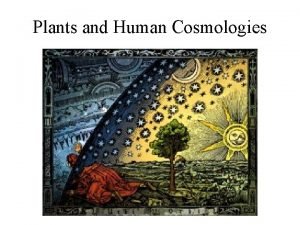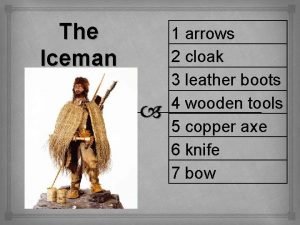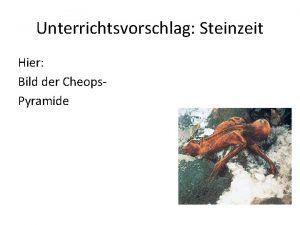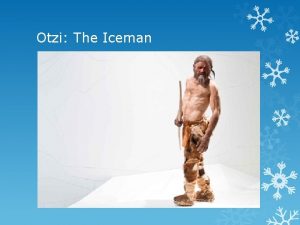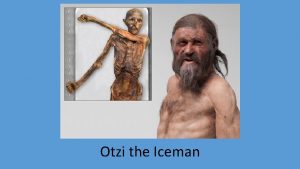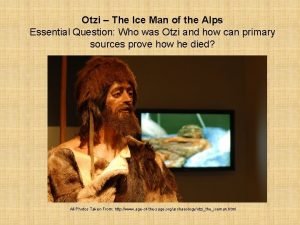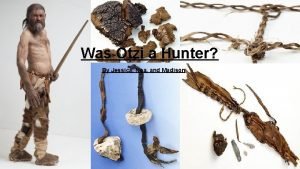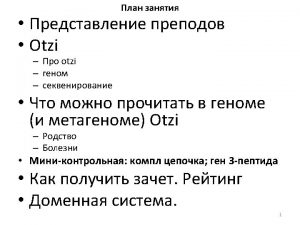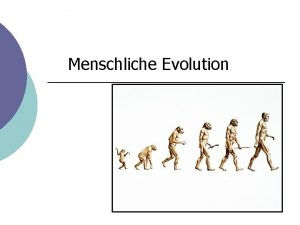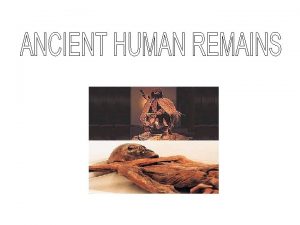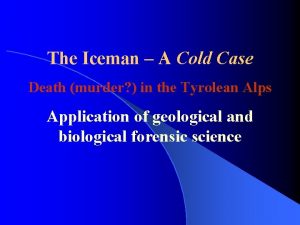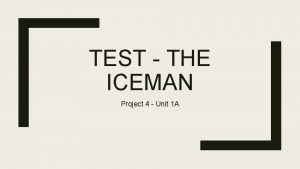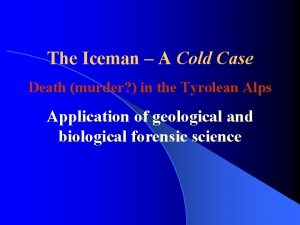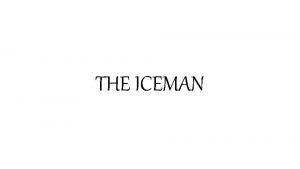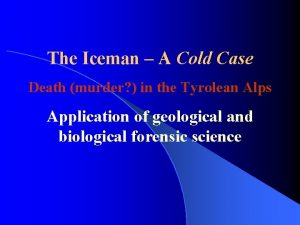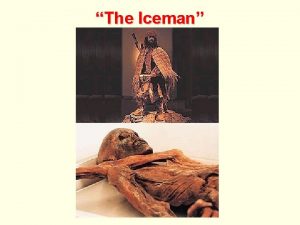Otzi the Iceman n o i t c


































- Slides: 34

Otzi the Iceman n o i t c u An d o r Int Reference: owenshistory. info/Powerpoints/03_Pre-History/Iceman. ppt accessed 23 Feb 15

Introduction �Otzi is a well-preserved natural mummy of a Chalcolithic (Copper Age) man from about 3300 BC. �On September 19, 1991 two German tourists climbing in the Ötztal Alps, near the border between Austria and Italy discovered a frozen body emerging from the glacier. �This frozen body would become known as the Iceman, and be one of the most exciting scientific discovery of its time.

Discovering the Iceman • Because of its state of preservation, the body was at first thought to be a modern corpse, like several others which had been recently found in the region. • Before the body was removed from the ice, people were allowed to see it, and some took portions of the clothing and tools as souvenirs.


Ötzi the Iceman while still frozen in the glacier, photographed by Helmut Simon upon the discovery of the body in September 1991


Another early photograph of the body before its removal from the ice.

Discovering the Iceman �Lying on its front and frozen in ice below the torso, it was crudely removed from the glacier by the Austrian authorities using a small jackhammer (which punctured the hip of the body) and ice-axes using nonarchaeological methods. • The body was then taken to a morgue in Innsbruck, where its true age was subsequently ascertained.


Damage caused by small jack hammer to Otzi’s hip when authorities attempted to remove his body from the ice.

The Body • Ötzi was approximately 1. 65 metres (5 ft 5 in) tall and weighed about 50 kilograms. He was about 45 years of age. • The body has been extensively examined, measured, X-rayed, and dated. • Tissues and intestinal contents have been examined microscopically, as have the items found with the body.


An early x-ray of Otzi


The Body – Stomach Contents • Analysis of Ötzi's intestinal contents showed his last meals (the last one about eight hours before his death), the most recent of red deer meat. • There was also some grain as well as some roots and fruits. The grain was a highly processed wheat bran, quite possibly eaten in the form of bread. • Also, pollen grains of hop-hornbeam were discovered. The pollen was very well preserved, indicating that it had been fresh (a few hours old) at the time of Ötzi's death, which places his death in the spring.

The Body - Health • Ötzi had whipworm, an intestinal parasite. • During CT scans, it was observed that three or four of his right ribs had been squashed when he had been lying face down after death, or where the ice had crushed his body. • His fingernail (only one was found) indicates he was sick three times in the six months before he died.

Whipworm found in Otzi’s intestines

The Body - Tatoos • Ötzi had approximately 57 carbon tattoos consisting of simple dots and lines on his lower spine, behind his left knee, and on his right ankle. • Using X-rays, it was determined that the Iceman may have had arthritis in these joints. It has been speculated that they may be related to acupuncture


Clothes • Ötzi's clothes were sophisticated. • He wore: – cloak made of woven grass and a coat – a belt, a pair of leggings – a loincloth made of leather of different skins. – He also wore a bearskin cap with a leather chin strap. – Shoes made of bearskin for the soles, deer hide for the top panels, and a netting made of tree bark. Soft grass went around the foot and in the shoe and functioned like modern socks.




Clothes • The coat, belt, leggings, and loincloth were constructed of vertical strips of leather sewn together with sinew. • His belt had a pouch sewn to it that contained useful items: a scraper, drill, flint flake, and a dried fungus to be used as tinder. • His shoes were waterproof and wide, designed for walking across snow

Items Found with the Iceman • • • 1/10/2022 Unfinished Bow Axe Backpack Ibex bones Two birch containers Dagger with scabbard Retoucher Belt pouch and contents Two pieces of fungi Tassel with marbel bead A net of grass string Quiver and aroows

Unfinished Bow, Quiver & Arrows • 182 cms long bow • Quiver had 2 arrows ready to use and 12 partly completed shafts

Copper Axe • Skin binding copper blade to yew handle. Only prehistoric axe ever found intact.

Dagger with scaabbard • Ash wood handle bound with animal sinew with flint blade. • Scabbard of grass cord and leather strap

Retoucher • Like a stubby pencil. Stag antler set into wooden handle. Used to sharpen flint tools.

Birch fungi • Antibiotic – a travelling medical kit?

Reconstructions of the Iceman

Questions…. . • Who was Otzi? • What was his occupation? (What did he do? ) • What was he doing in the mountains? • What can Otzi teach us about society in Europe during the Chalcolithic (Copper Age) period? • How did he die?

The Tattoos • The Iceman’s body is covered with 61 tattoos. • They have the form of groups of lines or crosses. • Unlike modern tattooing methods, the tattoos were not produced with needles but by means of fine incisions into which charcoal was rubbed. • Most of Ötzi’s tattoos are located on parts of his body that must have caused him pain during his lifetime due to degeneration or disease. • The tattoos were therefore probably intended as therapeutic measures rather than as symbols.

 Otzi
Otzi Iceman national geographic
Iceman national geographic Eli the iceman
Eli the iceman Eli the ice man
Eli the ice man Jäämies ötzi
Jäämies ötzi Halbwertszeit ötzi
Halbwertszeit ötzi Heimatpower
Heimatpower Otzi
Otzi Otzi battle theory
Otzi battle theory How did otzi die
How did otzi die Coca plant tattoo
Coca plant tattoo Was otzi a shepherd
Was otzi a shepherd Steinzeit pyramide
Steinzeit pyramide V cc
V cc 101012 bằng
101012 bằng Hát lên người ơi
Hát lên người ơi Hươu thường đẻ mỗi lứa mấy con
Hươu thường đẻ mỗi lứa mấy con đại từ thay thế
đại từ thay thế Vẽ hình chiếu vuông góc của vật thể sau
Vẽ hình chiếu vuông góc của vật thể sau Cong thức tính động năng
Cong thức tính động năng Tỉ lệ cơ thể trẻ em
Tỉ lệ cơ thể trẻ em Thế nào là mạng điện lắp đặt kiểu nổi
Thế nào là mạng điện lắp đặt kiểu nổi Hát kết hợp bộ gõ cơ thể
Hát kết hợp bộ gõ cơ thể Dot
Dot Lời thề hippocrates
Lời thề hippocrates Vẽ hình chiếu đứng bằng cạnh của vật thể
Vẽ hình chiếu đứng bằng cạnh của vật thể Quá trình desamine hóa có thể tạo ra
Quá trình desamine hóa có thể tạo ra độ dài liên kết
độ dài liên kết Các môn thể thao bắt đầu bằng từ đua
Các môn thể thao bắt đầu bằng từ đua Sự nuôi và dạy con của hổ
Sự nuôi và dạy con của hổ điện thế nghỉ
điện thế nghỉ Biện pháp chống mỏi cơ
Biện pháp chống mỏi cơ Trời xanh đây là của chúng ta thể thơ
Trời xanh đây là của chúng ta thể thơ Slidetodoc
Slidetodoc Voi kéo gỗ như thế nào
Voi kéo gỗ như thế nào

